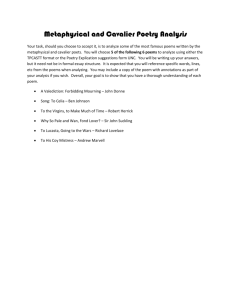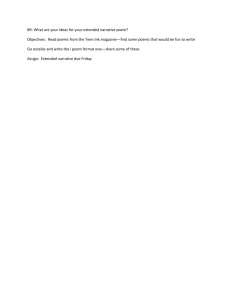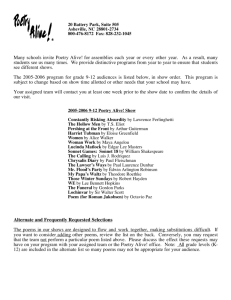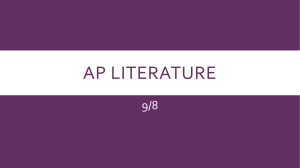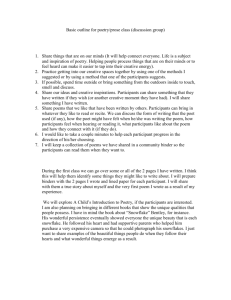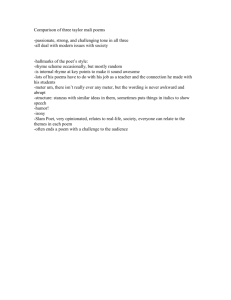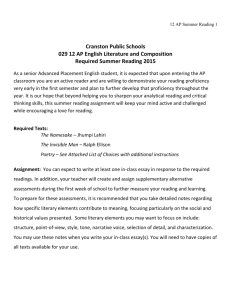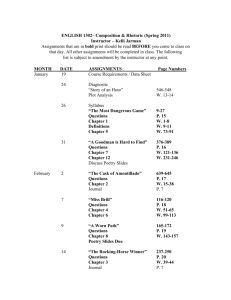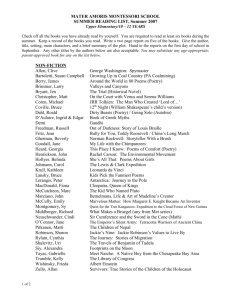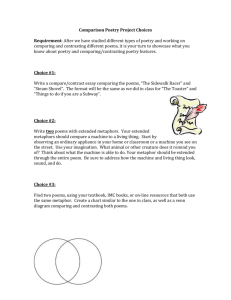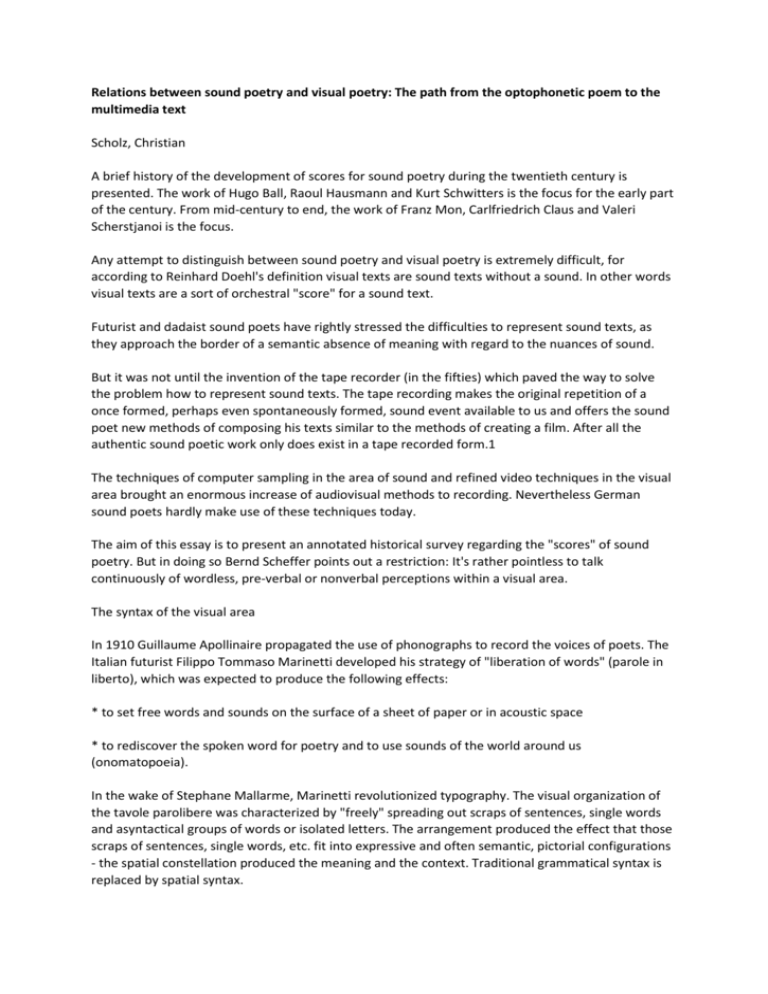
Relations between sound poetry and visual poetry: The path from the optophonetic poem to the
multimedia text
Scholz, Christian
A brief history of the development of scores for sound poetry during the twentieth century is
presented. The work of Hugo Ball, Raoul Hausmann and Kurt Schwitters is the focus for the early part
of the century. From mid-century to end, the work of Franz Mon, Carlfriedrich Claus and Valeri
Scherstjanoi is the focus.
Any attempt to distinguish between sound poetry and visual poetry is extremely difficult, for
according to Reinhard Doehl's definition visual texts are sound texts without a sound. In other words
visual texts are a sort of orchestral "score" for a sound text.
Futurist and dadaist sound poets have rightly stressed the difficulties to represent sound texts, as
they approach the border of a semantic absence of meaning with regard to the nuances of sound.
But it was not until the invention of the tape recorder (in the fifties) which paved the way to solve
the problem how to represent sound texts. The tape recording makes the original repetition of a
once formed, perhaps even spontaneously formed, sound event available to us and offers the sound
poet new methods of composing his texts similar to the methods of creating a film. After all the
authentic sound poetic work only does exist in a tape recorded form.1
The techniques of computer sampling in the area of sound and refined video techniques in the visual
area brought an enormous increase of audiovisual methods to recording. Nevertheless German
sound poets hardly make use of these techniques today.
The aim of this essay is to present an annotated historical survey regarding the "scores" of sound
poetry. But in doing so Bernd Scheffer points out a restriction: It's rather pointless to talk
continuously of wordless, pre-verbal or nonverbal perceptions within a visual area.
The syntax of the visual area
In 1910 Guillaume Apollinaire propagated the use of phonographs to record the voices of poets. The
Italian futurist Filippo Tommaso Marinetti developed his strategy of "liberation of words" (parole in
liberto), which was expected to produce the following effects:
* to set free words and sounds on the surface of a sheet of paper or in acoustic space
* to rediscover the spoken word for poetry and to use sounds of the world around us
(onomatopoeia).
In the wake of Stephane Mallarme, Marinetti revolutionized typography. The visual organization of
the tavole parolibere was characterized by "freely" spreading out scraps of sentences, single words
and asyntactical groups of words or isolated letters. The arrangement produced the effect that those
scraps of sentences, single words, etc. fit into expressive and often semantic, pictorial configurations
- the spatial constellation produced the meaning and the context. Traditional grammatical syntax is
replaced by spatial syntax.
As the antitraditional and revolutionary use of typographic design produces a peculiar visual effect of
expression - containing also acoustic qualities -- the text is approaching the picture and the musical
"score" thus transcending the borders of music and pictorial and fine arts.
Sound poems: Hugo Ball
The dadaist poet Hugo Ball knew the first examples of the tavole parolibere of the Italian futurists.
Yet the "typographic revolution" was not reflected in his poems. On July 23, 1916 he recited for the
first time his "Karawane" (Caravan), also called "Elefantenkarawane" (Elephant Caravan), together
with other sound poems in the Cabaret Voltaire in Zurich. The different written versions of this sound
poem were only authorized in the typescript, which is included in the manuscript edition of the
Gesammelte Gedichte (Collected Poems),2 whereas Ball didn't authorize the two "extra" elaborated
versions of this poem for the publication in the Dada-Almanach planned by Kurt Wolff and in the
Dada-Almanach edited by Richard Huelsenbeck and published by Erich Reiss, Berlin, in 1920.3
The visual version of the sound poem "Karawane" (figure i) is characterized by its headline, which
seems to be in motion, and the use of different types of writing in the seventeen lines of the text.
According to Jeremy Adler and Ulrich Ernst a sort of undulatory motion is produced by the alternative
use of italics and roman type, while the left column produces a soothing effect by using a
homogeneous type and small letters, thus bringing about a classical balance in the whole
composition.4 But the visual arrangement (for instance concerning the dynamic process) is not a
good start for the interpretation of this sound poem. Any interpretation must start with the title
which alludes to the recipient's imagination, thus giving him the impulse for the onomatopoeic
effects.5
The optophonetic poem: Raoul Housmann
Raoul Hausmann saw the lack of suitable means for recording sound poems and so he tried to solve
this problem by creating his "optophonetic poems." In 1918 he started writing his "Plakat" and
"optophonetische Gedichte" (Poster and optophonetic poems) - a unique poetic product of his
creative activities. Hausmann approached the methods of the plastic and graphic arts by creating the
optic and the acoustic dimension of the words and - with the help of typography - created his
"abstract poems," which were expected to disclose the meaning inherent in the letters.
Inspired by a reading of August Stratum in 1915, Hausmann's reflections on the "creation of an
energetic diction" first resulted in a new typographic development of the "modulation of speech." He
was then aware of the new quality of the futurist typography, which made him realize that "reading
or the communication of sound can only take an effect as an optical impression."6 "The new
typography was an optical support" for the "purely phonetic poems."7 As Hausmann's poems were
created in a printing-office by a purely accidental lining up of different letters in a row, he also called
the poems letter-poems, phonetic poems of letters or letter-posters.
Two of his first "letter-poems," both from 1918, "fmsbwt" and "OFFEAH" (figures), accidentally
created in the letter-case (probably as a mere proof), do not yet show the proclaimed visual qualities
which the tovole parolibere that the futurists had already achieved in 1915. Hausmann's printingsystem was still characterized by straight lines, the retention of writing left or writing right and the
simplicity and monotony of the chosen letters. Because of the mainly accidental construction of the
poster-poems the consonants of the letter-case dominated. The use of vowels and of consonants and
the forming of syllables of vocalic and consonantal elements were evidently reduced.
The accumulation of these vowels and syllables, connected with punctuation marks (hyphen, full
stop, question mark), which appear to be significant, is a real nuisance to the reader and - because of
the lack of well-known words and associations of words (interpretation of the sound) - prevents
intelligibility. These poets consciously denied the use of language asa means for discursivity
Hausmann; revolt against normal listening and reading habits jeopardized the familiar relation
between writing and meaning.
But this chance operation was not the only principle of creation. By replacing single letters forthe
sake of certain acoustic qualities in "OFFEAH," Hausmann showed his intention to form his material.
"I had four different copies of these poems printed. Because of the tone colour I later eliminated the
m ii of the first poem and replaced it by the qu i ie of the second."8 Hausmann also used vowels
mainly to comprehend the sound forming course of motion in all phases of modulation.
In 1918 or 1919, Hausmann created the sound poem "kp'erioum" (figure 3), in which he continued
the compository tendencies of the two former poster-- poems and widened them out into the
"optophonetic poem." The visualization of the letters on the surface of a sheet of paper caught the
spectator's eye. The typographic arrangement approached the tavole parolibere of the Italian
futurists who for instance tried to express the loudness and the pronunciation of their combinations
of letters by capital letters or bold type. According to Hausmann the reader was expected to hear the
intended sounds with the help of the optical structure of the poem. "The letters of a sound poem are
arranged in such a way that they convey the sound."9
The flowing of the vowels evidently seems to be stopped by the static character of the consonants.
By itself their graphic variety provides our interior ear with familiar signals which can easily be
transformed into phonemes by our memory of communication and illustrates the transition of sound
to word, of lines without a meaning to writing. Hausmann's reading of his sound poems, "kp'erioum,"
for example, is available on records of the fifties and sixties.10 But they do not really represent the
"original" sound of the dada years, as the reading is hampered by an antiquated usage of speaking.
"Associations of sounds - almost audible onomatopoetica, reminiscences of foreign languages"" - can
be perceived. The consequence is that sound poets must give up the attempt to record sound poems
visually in a kind of "notation," which can be duplicated only by poets.
Comments: Kurt Schwitters"' "Ursonate"
We know from Kurt Schwitters's publications that he insisted on the sound recording of his works,
especially of his"Ursonate." Schwitters's cooperation with the "Suddeutscher Rundfunk Stuttgart"
(South German Radio Stuttgart) in the year 1932 is preserved in the German Radio Archive in
Frankfurt/ Main. A few years ago the complete reading of the "Ursonate" (with a reading time of
about forty-one minutes) was published by WERGO, Mainz.12 The long process of coming into being
of this sound poem - Schwitters started writing it already in 1921 - shows the poet's difficulties with
the written version and the publication of this sound poem. The complete version of the "Ursonate"
appeared in 1932 (Men 24), typographically prepared by Jan Tschichold, as the cooperation of El
Lissitzky failed.
Kurt Schwitters's "Ursonate" does not show the high visual qualities of Raoul Hausmann's
"optophonetic poems." This is the result of Schwitters's specific method of composing and creating
neologisms. Unfortunately space prevents going into details13 and analyzing Jan Tschichold's
typographic version of Schwitters's "Ursonate" as compared with Schwitters's "score" of the
"Ursonate" which does exist. Excerpts of the notation, respectively the .score" of the "Ursonate,"
which would be of interest for this essay, have not been published up to now by the publishing
houses Arche, Zurich, and Haymon, Innsbruck. The existence of a "score" shows, however,
Schwitters's hope that other interpreters would recite his "Ursonate."
Articulations: Franz Mon
"(A)rticulations"14 from 1959 was Franz Mon's first publication, containing texts, essays and some
sound poems. "Articulations," reflected phonetic experiments of the 192os. Of course it was according to Mon - problematic to fix an "articulation" in writing, for it was in the poet's view an
acoustic presentation. It was hardly possible to reproduce in writing the "complete movement of the
articulation, the range of articulation between the extreme poles of vocal sounds and the
consonantal plosives."15
There was, however, a special course of articulation that was connected with the written and graphic
presentation. A typical example for this form of presentation is the sound poem "aus was du wirst"
(of that which you consist) (flgure 4), contained in the volume "articulation" and in the anthology
Movens.16
Indeed there are several variant readings for this "articulation," but only one of them is really
striking, namely the variant which must be read diagonally from top to bottom and must be
duplicated in an "attempt of concentration" by the recipient-reader-viewer.'7 In this we can see that
the alleged "simultaneous pattern" offers relations in every possible direction provided the spectator
is willing to use the time to develop an intentional understanding of a special kind of speaking
beyond the normal way of speaking.18 Thus, "speaking immediately along the axis of articulation in
the form ofa dance of the lips, the tongue and the teeth. "19
The creative object is formed by the spectator's endeavor - the noted down text is only "a rough
copy, an instruction for what cannot be fixed since beyond the stream of meditation.2The recipient
must set the "tremendous complexes (of the simultaneous pattern) into motion,"21 contained in the
totality produced according to strict rules with a clear reduction of semantic meaning.22
In the "articulation" "aus was du wirst" the course of the articulation is already mentioned in the
title: "Its identity is preserved by changing the well-known into the similar and so on."23 The single
syllables which the recipient-reader-- viewer is expected to pick up are specified on the coarsemeshed raster. In the process of articulation the initial form "rakon" develops - about the
remembered syllable of "kram," "hare," etc. - into the final form "drustar." The same can be applied
to the sequence of sounds in the lines above, but with certain restrictions: The sounds develop in a
different way, i. e., sometimes without a widening effect ("egs," "drie," "odt"), sometimes by way of
variations ("kram," "kras," "kars"), by polishing ("tar," "usd") and reducing ("md," "rd," "hn")
respectively they become "rigid" in the final point.
Carlfriedrich Claus was "a performer" among those readers who accepted the exercises to duplicate
the "articulations" "aus was du wirst," "sinks" and "fast durchlassig" with the help of their own
organs of speech. As "a performer," he describes "his experiences with the speech in a review of
Mon's book "articulations": Speech is here in its microscopic aspect (the transparency of the single
phonemes concerning the gestures and tininess behind) and the macroscopic aspect of the
multilateral processes. On different levels different processes are happening. The structures of time
of these processes differ. They proceed 'simultaneously' but at a different speed. In addition there is
the primary moment that typographies are concerned. By way of distribution and by the
arrangement of the substance of writing the typographies start in the spectator's mind an optical
process (because: letter is equivalent to acoustic signal) which produces[or] initiates an acoustic
effect first, then a mental effect... 24
"Konstellative Artikulationen"
(articulations In the form of constellations): Carlfriedrich Claus
About 1954 Carlfriedrich Claus tried to record certain experiences or perceptions of speech (events
or productions of the speech) and natural experiences "in pure forms of sound"25 and to provide a
written notation of "sound texts" like "tong tong"26 (figure 5).
In 1959 Claus made experiments with his so called "Letternfeld" (a field of letters)27 (figure 6). A
"Letternfeld" is an arrangement of vocals or vocals and consonants in typescript. In his "experiment"
Claus tried to transform his "Letternfeld" into his "konstellative Artikulation" (articulation in the form
of a constellation). For this purpose Claus made use of a microphone, a stop-watch and the trick
button of a type recorder (switching off the erase button during the process of recording), which
made it possible for him to interrupt recordings with other recordings on the same sound track.
The constellation of the two letters "i e" was recited several times and in a sort of temporal phase
displacement thus producing a "konstellative Artikulation" (articulation in the form of a
constellation) with a simultaneous and/or alternative "flashing" of the two vowels "I" and "e."28
Because of the restricted possibilities of a tape-recorder, planned for simpler needs at home, the
experiment was only to an extent successful. Claus's sound poetic work, which he has created since
1959 is based on spontaneous improvizations of speech (respectively sound) or noise. These
improvisations were recorded and transformed into sound texts, later broadcast by the West
German Radio (Cologne) and the Bavarian Radio (Munich).29
Graphic representations of sound poems: Valeri Scherstianol
Valeri Scherstjanoi, born 1951 in Kazachstan, has lived in Germany (East) since 1979 and made
friends with Carlfriedrich Claus. Deeply influenced by the Russian futurists, he uses Russian and
German vocabularies and phonemes (respectively microparticles of phonemes)30 which can be seen
in his "Bavarian sound poem" (1998) (figure7) and various notations of sound poems using Russian
and German phonemes "Die Enge" (The narrowness), 1996 (figure 8).
Scherstjanoi opposes the merely vocal improvisations that avoid any form of written notation of
sound poems and tries to replace the notation ofsound poems with the help of mere electroacoustical methods of production. Scherstianoi thinks that mere electro-acoustical methods of
production tend to develop into sheer abstractions of sounds.31 In contrast, Scherstianoi tries to
keep a certain sound idea within its own limits, to put it down in writing and even to learn it by heart.
For Scherstjanoi sound poetry must remain poetry, a mixture of sound and meaning.
The author describes the creation of his sound texts as follows:
1. Noting down - pronouncing the sounds in a loud or a slow voice, reading - taping - speaking
(saying) etc.
2. Speaking - taping, listening to the recorded sounds - saying, listening to the recorded sound noting down - saying .... As reading as I have written ... The hand-written texts are sound texts. The
eyes see what the ears have heard ... The ears 'hear' the atmosphere of writing.32
With full concentration, the recipient-reader-viewer is able to re-enact in his mind the sound ideas
which Scherstjanoi is performing on the stage. Cooperating with artists like Zoro Babel (percussionist)
and video artists like Peider A. Defilla, Scherstjanoi's video performances increase the perception of
the sound ideas. Apart from this effect, the visual level of the video films reflect Scherstjanoi's special
kind of articulations. In this way the genius of both artists is maximized in their output.33
The multimedia text
Already in 1984 the Canadian author BP Nichol adapted some visual poems for the AppleComputer.34 This software makes the texts visible in a temporal course on the screen and reminds
us of the reduction of animation of letters in the visual sphere. The development of computer
technology gives us a chance to adapt poems, i. e., the combination of texts, graphics, sounds, video
clips etc. Experiments of this kind are emerging.35
Sound poetry is an art full of vigor which changes continually. The future of visual and sound poetry
lies according to the author, on one hand, in the possibilities of computer technology (digital
recording, adaptations, integrations of different texts, etc.). But it is not until new digital recording
possibilities and the appearance of people who manage without the burden of the past (futurism,
dadaism, concrete poetry), that new perspectives in the future will open. On the other hand, this
development will proceed only by means of the genius of sound poets exploring the form of speech
and the "alchemy of words" (Hugo Ball) on a sheet of paper and on stage without using any technical
aids, to demonstrate the flexibility of the letters, the words and the microparticles of speech.
1 Mon, Franz. 1994. Franz Mon: Essays. Berlin: Gerald Wolf Janus Press, 318.
2 Ball, Hugo. 1963 Gesammelte Gedichte (Collected poems). Zurich: Verlag der Arche, 28.
3 Reprinted in Arp, Hans, and Richard Huelsenbeck, Tristan Tzara. 1957. Dichtungen der Grunder /
Dada Gedichte (Poetry of the originators / Poems of the Dadaists).
Zurich: Verlag der Arche, 43.
4 Adler, Jeremy and Ulrich Ernst. 1988. Text als Figur. Visuelle Poesie von der Antike bis zur Moderne
(Text as shape. Visual poetry from the beginnings to the modern times).
Weinheim: VCH, 265.
5 E. g. Ball, Hugo. 1978. Karawane, performed by "EXVOCO" (FUTURA. poesia sonora. Arrigo LoraTotino, editor. Milan: Cramps Records, 7 LPs.
For further details about Ball's sound poetry see the author's website: http://www.fen.baynet.de/
christian.scholz (including comments on Hausmann's, Mon's, Claus's sound poetry)
6 Hausmann, Raoul, 1933. "Typographie." In: Hausmann, Raoul. 1982. Texte bis Vol. 1. Munich:
edition text + Kritik, 183.
7 Hausmann, "Typographie," 183.
8 Hausmann, Raoul, 1958. Poeme phonetique. In Hausmann, Raoul. Coumer Dado. Paris: Editions Le
Terrain Vague, 63.
9 Hausmann, Raoul. 1969. "Recherches sur le poeme phonetique" In De Tafelronde 14:3/4, 107.
10 E.g., digitally remastered recordings of the fifties and sixties. Hausmann, Roaul. 1997. Poemes
Phonetiques. Rochechouart: Musee Departmental d'Art Contemporain; Limoges.
11 Erlhoff, Michael. 1982 Raoul Hausmann, Dadasoph. Hannover: Verlag zweitschrift, 195.
12 Schwitters, Kurt. 1932. Scherza der Ursonate (5. Mai 1932). In "lunapark 0,10." Marc Dachy,
editor. 1999.
Marc Dachy, editor.1999. Brussels: sub rosa (SR So). Schwitters, Kurt. 1993. Ursonate. Original
Performance by Kurt Schwitters. Mainz: WERGO records (WER 63042).
13 Scholz, Christian, 1989. "On Kurt Schwitters's URSONATE (1932)." In Musicworks 44. 7-23.
14 Mon, Franz. 1959. artikulationen. Pfullingen. (Without pagination).
15 Mon, Franz. 1960. [statement]. In Mon, Franz, editor. Movens. Wiesbaden: Limes Verlag, 113.
16 Mon, 111. Franz Mon "aus was du wirst," artikulationen. Pfullingen. Also in Mon, Movens, 113.
17,18
Mon, 111. Franz Mon "aus was du wirst," articulationen. Pfullingen.
19. Mon, artikulationen. Pfullingen, 31.
20,21,22,23
Mon, Artikulationen, Movens, 111.
24 Carlfriedrich Claus. 1960. "Sicht-, hdrbare Phasen umfassender Prozesse" (Visible and audible
phases of comprehensive processes). Nota 4, 42.
25 Carlfriedrich Claus's discourses with Christian Scholz. 1990. Chemnitz-- Obermichelbach, tape.
26 Carlfriedrich Claus. iggi. "tongtong."
In Carlfriedrich, Claus. Erwachen am Augenblick (To be roused by the instant). SprachblItter. Karl-Marx-Stadt, Munster, 54.
27 Lora-Totino, Arrigo, editor. 1978. FUTURA.. poesia sonora. Milan: Cramps Records, 7 LPs.
28 Carlfriedrich Claus. 1991. "Letternfeld." In Carlfriedrich Claus. Erwachen am Augenblick (To be
roused by the instant). Sprachblatter. Karl-MarxStadt, Munster, 113.
29 Carlfriedrich Claus. 1993. "Lautaggregat." WDR Cologne: Studio Akustische Kunst. Chemnitz:
Stadtische Kunstsammlungen. 1995 (001-95-CC). Carlfriedrich Claus. 1996. Basale Sprech-OperationsrAume. Bavarian Radio, Munich.
30 Scherstianoi, Valeri. Interview.
http:/www.dickinson.edI departments/jermnglossen/ heftgvaleri.html
31 Scherstianoi, Valeri. 1996. In "den Rhythmen der Sprache oder wie gehe ich an die Produktion
meiner Lauttexte heron?" (In the very rhythms ofthe speech or how I approach the creation of my
sound texts?) Berlin, AprilMay, manuscript, 2 pages.
32 Scherstjanoi, "den Rhythmen der Sprache," 1
33 Scherstjanoi, Valeri. 1999. "Zwischen Herz and Him" (Between heart and brain). Video
Performance by Valeri Scherstjanoi and Zoro Babel. Video Camera by Christoph Wirsing. Munich:
B.O.A. Vdeofilmkunst Peider A. Defilla, July 16.
34 Nichol, BP 1984. "First Screening." Toronto: Underwhich Editions (Underwhich Software Series 1).
35 Wendt, Larry. 1995. Narrative and the World Wide Web. Art & Design, 45, "The Multimedia Text,"
82-91.
CHRISTIAN SCHOLZ
Rothenberg Weinberstrasse 11 D-90587 Obermichelbach Germany
--Christian Scholz is a scholar of sound poetry. Since the mid-197os he has been a publisher of this
form of oral research. Additionally, he has published books about German sound poetry and edited
radio programs on the topic.
Copyright Visible Language 2001
Provided by ProQuest Information and Learning Company. All rights Reserved

